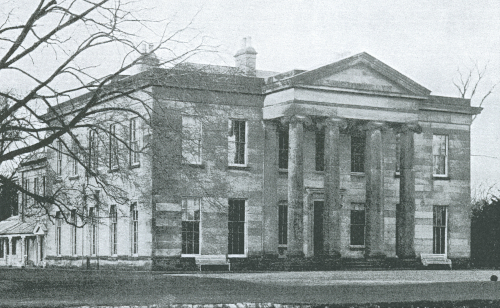Ashfield Hall
Cheshire
| Location | Neston | ||
| Year demolished | 1958 | ||
| Reason | Damage during WWII requisitioning, now farm storage | ||
| See all images: | Gallery | ||
| << Back to the main list |
Text kindly provided by, and © of, Andrew Lamberton
A classical stone building with a central Ionic portico, it was built in 1820 for Joseph Hayes Lyon probably by John and Edward Haycock of Shrewsbury. The grey stone blocks were transported from North Wales by sea to Parkgate where the owner had business interests.
 On Joseph Lyon’s death, the estate was inherited by his brother, John Winder Lyon Winder and in 1845, in his possession, the Hall was described as “One of the finest modern mansions in this part of the country.” Joseph Lyon’s only daughter, Mary Anne Jane, married Uvedale Corbett in 1817. They had a son called Uvedale Corbett who later succeeded to the estate. In 1857, Robert Mafie, who owned a sugar refinery in Liverpool, moved in to Ashfield Hall and was still living there in 1878. In 1892, the Hall was listed as belonging to Uvedale Corbett M.A., .J.P. He died some three years later and was succeeded by his son, Reginald William Uvedale Corbett.
On Joseph Lyon’s death, the estate was inherited by his brother, John Winder Lyon Winder and in 1845, in his possession, the Hall was described as “One of the finest modern mansions in this part of the country.” Joseph Lyon’s only daughter, Mary Anne Jane, married Uvedale Corbett in 1817. They had a son called Uvedale Corbett who later succeeded to the estate. In 1857, Robert Mafie, who owned a sugar refinery in Liverpool, moved in to Ashfield Hall and was still living there in 1878. In 1892, the Hall was listed as belonging to Uvedale Corbett M.A., .J.P. He died some three years later and was succeeded by his son, Reginald William Uvedale Corbett.
In 1910, the Hall and Estate were put up for sale. In the sales particulars, the principal rooms were listed as entrance hall 21ft 6in x 18ft, inner hall 23ft x 17ft 6in, library 21ft x 20ft, dining room 30ft x 20ft, large drawing room 30ft x 20ft, smaller drawing room 21ft x 29ft,(these can be joined together to form a magnificent saloon) billiard room 29ft x 20ft with ante room12ft 6in x 11ft and large conservatory adjoining, servants’ hall 19ft x 16ft, 10 principal bedrooms with dressing rooms, 13 servants’ bedrooms, kitchen, scullery, pantry, cylinder room, butler’s room, and cellars in basement.
In 1914, it was the home of Henry Mathison Beausire Esq. and it was known that later, Sir John Harmood Banner lived here.
In 1939, it was empty, but in the September of that year, it was commandeered for use by the military and C Company of the 4th Battalion the Cheshire Regiment were billeted here. They were followed by the Royal Artillery and No.60 Railway Construction company of the Royal Engineers. The army left the Hall in 1942 and the Ministry of Aircraft Production took over the Hall and used it to store aircraft parts for Vickers Armstrong.
In 1958, it was reduced in height to a single storey and is unrecognisable today being used as a barn for farm storage.